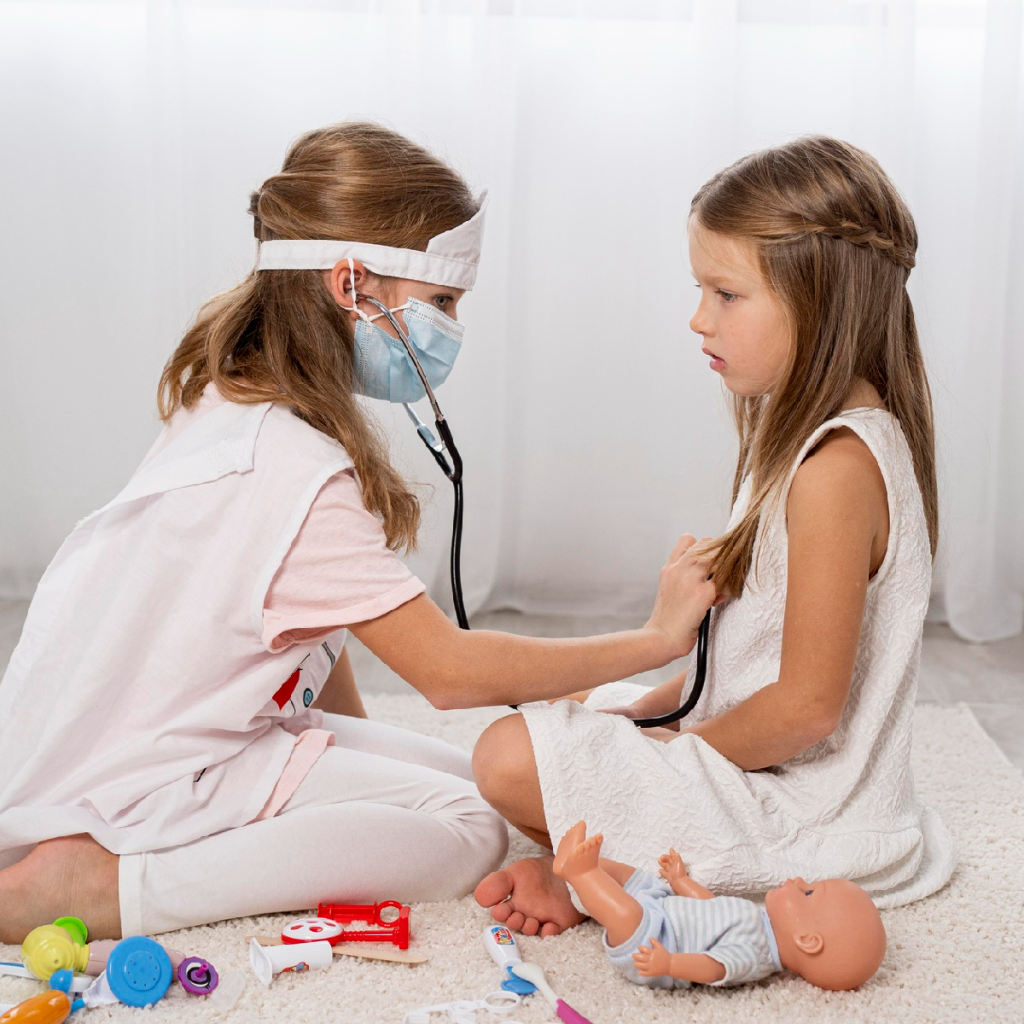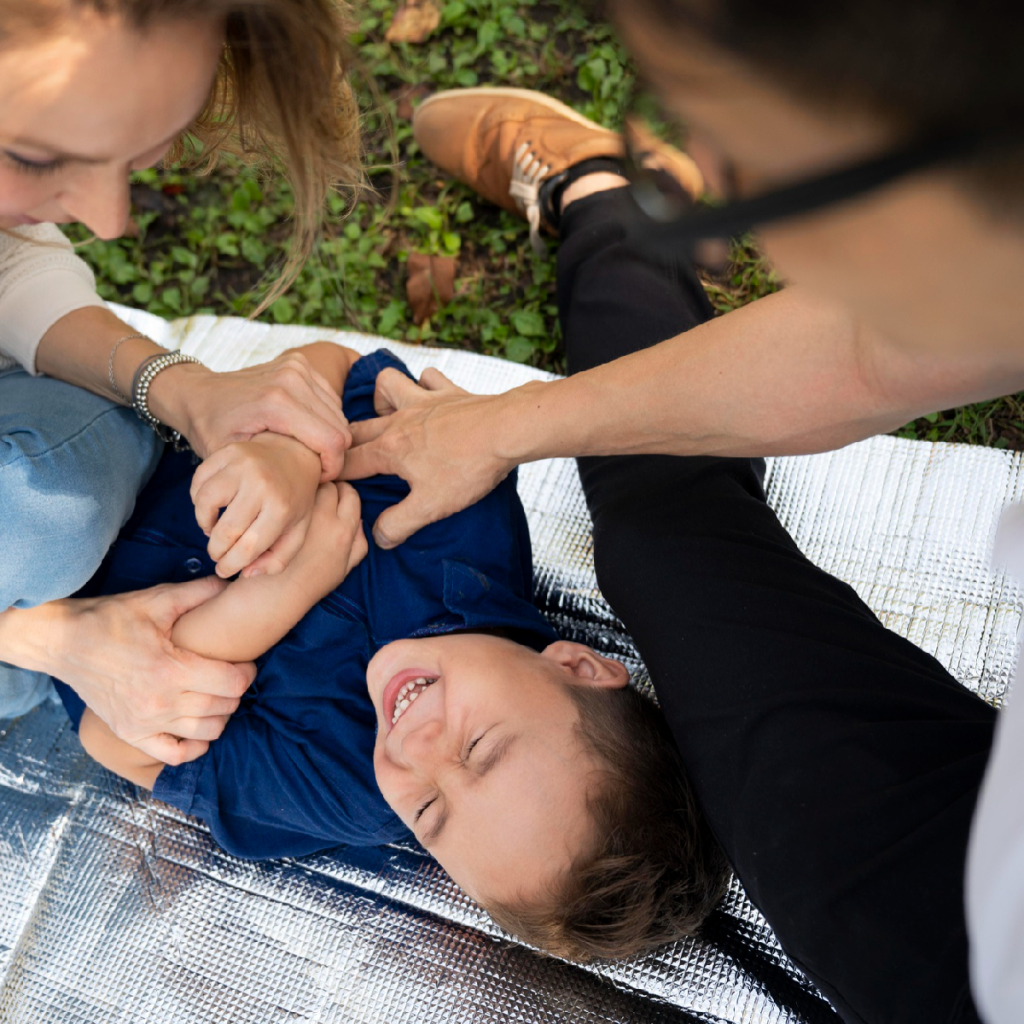Learn how to effectively teach basic first aid skills to 4-5 year old children in this informative article.
Teaching Basic First Aid to 4-5 Year Old Children
Teaching basic first aid to 4-5 year old children is not only an important life skill, but it can also be a fun and interactive way to keep them safe. In this article, we will explore the importance of first aid for young children, the basic concepts they need to understand, effective teaching techniques, and the essential topics to cover. Plus, we’ll discuss how to reinforce their first aid knowledge at home. So, let’s dive right in!

Understanding the Importance of First Aid for Young Children
When it comes to child safety, first aid plays a vital role. Accidents and injuries can happen at any time, and having the knowledge and skills to respond quickly can make all the difference. Teaching young children basic first aid can give them the confidence to act in emergencies and potentially save lives.
Imagine a scenario where a child is playing in the park and suddenly trips and falls, injuring their knee. Without any knowledge of first aid, the child may panic and not know what to do. However, if the child has been taught basic first aid, they would know to assess the situation, clean the wound, and apply a bandage to prevent further injury and infection. This simple act of first aid can provide immediate relief and comfort to the child, and may even prevent the need for further medical intervention.
The Role of First Aid in Child Safety
First aid is not just about bandaging wounds. It also involves teaching children how to recognize dangers, make safe choices, and take appropriate action. By understanding the basics of first aid, children can learn to protect themselves and others in a variety of situations.
For example, first aid education can teach children about the importance of fire safety. They can learn how to identify potential fire hazards, such as leaving candles unattended or playing with matches, and what steps to take in case of a fire. By knowing how to safely evacuate a building, use a fire extinguisher, or call emergency services, children can play an active role in preventing fire-related accidents and potentially save lives.
Benefits of Early First Aid Education
Introducing first aid education at an early age has numerous benefits. It helps children develop critical thinking skills, boosts their confidence and resilience, and instills a sense of responsibility.
When children learn first aid, they are encouraged to think quickly and make decisions under pressure. This critical thinking skill can be applied not only in emergency situations but also in everyday life. They learn to assess risks, think logically, and take appropriate action, which can be invaluable skills as they grow older.
Furthermore, learning first aid can also be a stepping stone to future careers in healthcare or emergency services. By exposing children to the world of first aid, they may develop a passion for helping others and pursue careers as doctors, nurses, paramedics, or firefighters. Early exposure to first aid education can ignite a lifelong interest in healthcare and emergency response, opening doors to a wide range of fulfilling and impactful careers.
Basic First Aid Concepts for Children
Explaining first aid to young children may seem challenging, but with the right approach, it can be both educational and enjoyable. Let’s take a look at how we can break down the concepts in a way that they can understand.
Explaining First Aid to a Child
Start by explaining that first aid is like a superhero power that helps people when they get hurt. Emphasize that anyone can learn it, and it’s not just for grown-ups. Use simple language and age-appropriate examples to illustrate the importance of quick thinking and taking care of ourselves and others.
Imagine a scenario where a child falls off their bicycle and scrapes their knee. You can explain to them that knowing first aid would enable them to clean the wound and apply a bandage, just like a superhero coming to the rescue. By teaching them these skills, they become empowered to help themselves and others in times of need.
Furthermore, you can engage their imagination by describing how first aid knowledge can turn them into real-life heroes. They can be the ones to save the day when a friend gets a splinter or a sibling gets a nosebleed. This not only makes learning first aid exciting but also instills a sense of responsibility and empathy.
Essential First Aid Skills for 4-5 Year Olds
Teaching basic first aid skills to young children should focus on simple actions they can take to help in common situations. For example, teach them how to apply a bandage to a minor cut or scrape, the importance of washing hands to prevent infection, and how to recognize and respond to choking. Keep the instructions clear, concise, and easy to remember.
Let’s delve deeper into some of these essential first aid skills for 4-5-year-olds. When teaching them how to apply a bandage, you can demonstrate on a stuffed toy or use colorful illustrations to make it more engaging. Encourage them to practice on their own toys, turning it into a fun and interactive game.
Another crucial skill to teach is the importance of handwashing. Explain to them that washing hands with soap and water helps get rid of germs that can make us sick. You can even demonstrate the proper handwashing technique, singing a catchy song together to make it more enjoyable.
Lastly, it’s vital to educate young children about recognizing and responding to choking. Use age-appropriate visuals to show them what to do if someone is choking, such as the universal sign for choking and how to perform back blows or abdominal thrusts. Reinforce the importance of seeking help from an adult in such situations.
Remember, when teaching first aid to young children, repetition is key. Encourage them to practice these skills regularly, so they become second nature. By empowering them with these essential first aid skills, you are not only equipping them with potentially life-saving knowledge but also fostering a sense of confidence and compassion.
Teaching Techniques for First Aid Education
Making first aid education fun and engaging plays a crucial role in capturing and maintaining children’s interest. Let’s explore some techniques that can breathe life into the lessons.
When it comes to teaching first aid to children, using visual aids can be incredibly effective. Visual aids, such as posters and pictures, can help children grasp first aid concepts more effectively. For example, you can use colorful illustrations and diagrams to explain different scenarios, such as how to check for breathing or the steps to follow when calling emergency services. By incorporating visual aids into the lessons, you can make learning visually stimulating and memorable.
In addition to visual aids, incorporating play into first aid lessons can be highly beneficial. Children learn best through play, so why not make learning first aid a playful experience? One way to do this is by using toys or role-playing games to demonstrate how to provide first aid. Encourage children to dress up as doctors or paramedics and pretend to help their stuffed animals or dolls. By engaging in these playful activities, children are more likely to remember what they’ve been taught and feel more confident in their ability to apply first aid techniques.
Furthermore, storytelling can be a powerful tool in teaching first aid. Create engaging stories that revolve around first aid situations and encourage children to imagine themselves as the heroes who save the day. By weaving first aid concepts into these stories, children can develop a deeper understanding of the importance of first aid and how to apply it in real-life situations.
Another technique that can be effective is the use of interactive technology. Incorporate educational apps or online games that focus on first aid education. These interactive tools can make learning more engaging and interactive, allowing children to practice their skills in a virtual setting. By utilizing technology, you can create a dynamic learning experience that keeps children actively involved and motivated.
Lastly, consider inviting guest speakers who have firsthand experience in providing first aid. This could be a paramedic, a nurse, or even a firefighter. By hearing real-life stories and experiences, children can gain a deeper appreciation for the importance of first aid and the impact it can have on saving lives.
First Aid Topics to Cover with 4-5 Year Olds
Now that we have discussed the teaching techniques, it’s time to explore some essential first aid topics that you should cover with 4-5 year olds.
Treating Minor Cuts and Scrapes
Show children how to clean a cut or scrape with mild soap and water. Teach them how to apply a bandage or adhesive strip gently. Explain the importance of not picking at scabs and keeping the wound clean to promote healing.
Recognizing and Responding to Choking
Teach children how to recognize the signs of choking, such as coughing, clutching the throat, or being unable to speak. Instruct them to call for help and encourage them to “cough it out” if someone is choking and can still make sounds. Reinforce the importance of never putting anything in their mouths that could cause choking.
What to Do in Case of a Fire
Explain the importance of fire safety and what children should do in case of a fire. Teach them to stop, drop, and roll if their clothes catch fire and to crawl under smoke to find an exit. Show them how to use a fire extinguisher (if age-appropriate), as well as the importance of calling emergency services.
Reinforcing First Aid Knowledge at Home
Learning first aid doesn’t stop in the classroom. Encourage children to practice what they’ve learned at home in a safe and supervised environment.

Regularly Practicing First Aid Skills
Set up scenarios where children can demonstrate their first aid skills. For example, have them pretend their teddy bear fell and got a scrape. Ask them to clean the “wound” and apply a bandage. Praising their efforts will boost their confidence and motivate them to continue learning.
Creating a Safe Environment for First Aid Practice
Keep basic first aid supplies accessible, such as adhesive strips, antiseptic wipes, and child-friendly bandages. Encourage children to play “doctor” or “nurse” and create opportunities for them to practice their skills. By integrating first aid into their playtime, children will develop a deeper understanding of its importance.
Teaching basic first aid to 4-5 year old children can be a rewarding experience for both educators and young learners. By understanding the importance of first aid, breaking down concepts into digestible pieces, and employing engaging teaching techniques, we can equip children with the knowledge and skills they need to keep themselves and others safe. Remember, learning through play is the key, so let’s make first aid a fun and interactive adventure!



